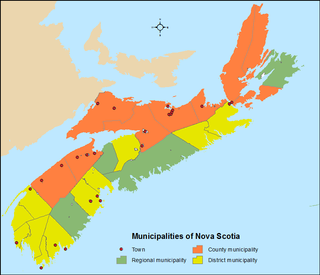Related Research Articles

A municipality is usually a single administrative division having corporate status and powers of self-government or jurisdiction as granted by national and regional laws to which it is subordinate.
The term township, in Canada, is generally the district or area associated with a town. The specific use of the term to describe political subdivisions has varied by country, usually to describe a local rural or semirural government within the country itself.
A regional municipality is a type of Canadian municipal government similar to and at the same municipal government level as a county, although the specific structure and servicing responsibilities may vary from place to place. Regional municipalities were formed in highly populated areas where it was considered more efficient to provide certain services, such as water, emergency services, and waste management over an area encompassing more than one local municipality. For this reason, regions may be involved in providing services to residents and businesses.

The census geographic units of Canada are the census subdivisions defined and used by Canada's federal government statistics bureau Statistics Canada to conduct the country's quinquennial census. These areas exist solely for the purposes of statistical analysis and presentation; they have no government of their own. They exist on four levels: the top-level (first-level) divisions are Canada's provinces and territories; these are divided into second-level census divisions, which in turn are divided into third-level census subdivisions and fourth-level dissemination areas.

Halifax is the capital and largest municipality of the Canadian province of Nova Scotia, and the largest municipality in Atlantic Canada. Halifax is one of Canada's fastest growing municipalities, and as of 2022, it is estimated that the CMA population of Halifax was 480,582, with 348,634 people in its urban area. The regional municipality consists of four former municipalities that were amalgamated in 1996: Halifax, Dartmouth, Bedford, and Halifax County.
An unorganized area or unorganized territory is any geographic region in Canada that does not form part of a municipality or Indian reserve. In these areas, the lowest level of government is provincial or territorial. In some of these areas, local service agencies may have some of the responsibilities that would otherwise be covered by municipalities.
Local government in Canada can be defined as all elected local authorities which are legally empowered to make decisions on behalf of its electors, excluding the federal government, provincial and territorial governments, and First Nations, Métis and Inuit governments. This can include municipalities, school boards, health authorities, and so on.
A municipal district is an administrative entity comprising a clearly-defined territory and its population. It can refer to a city, a town, a village, a small grouping of them, or a rural area.

The Municipality of the District of Chester is a Nova Scotia district municipality occupying the northeastern half of Lunenburg County, Canada.
Canada has a total of 3,573 municipalities among its 10 provinces and 3 territories that are subject to some form of local government.

A rural municipality is a classification of municipality, a type of local government, found in several countries.

The Canadian province of Nova Scotia is divided into 49 municipalities, of which there are three types: regional (4), town (25), and county or district municipality (20).
References
- ↑ "Local Government Act (RSBC 1996) CHAPTER 323". Queen's Printer (British Columbia). Archived from the original on 8 July 2007. Retrieved 26 July 2007.
- ↑ "Municipal Government Act" (PDF). Office of the Legislative Counsel, Nova Scotia House of Assembly. 19 June 2012. p. 16. Retrieved 9 January 2017.
(aw) "municipality" means a regional municipality, town or county or district municipality, except where the context otherwise requires or as otherwise defined in this Act;
- ↑ "The Establishment of Elective Rural Municipal Government in Nova Scotia" (PDF). Government of Nova Scotia: Department of Municipal Affairs. pp. 1, 2. Retrieved 9 January 2017.
- ↑ "Interim List of Changes to Municipal Boundaries, Status, and Names: From January 2, 2014 to January 1, 2015 (Table A: Census subdivision types by province and territory, as of January 1, 2015)". Statistics Canada. 27 May 2015. Retrieved 9 January 2017.